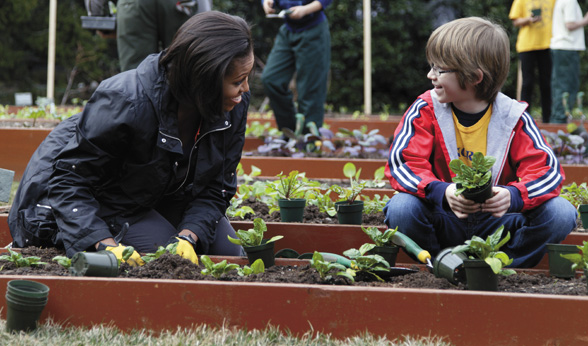Each bed at the Hamnett Place Community Garden is individually cared for by members who select what to grow and how to tend it. Some harvest for their families, others share with neighbors or sell at local farmers’ markets. (Photo by Tessa Williams/Pittsburgh’s Public Source)
The borough has more than 1,600 vacant lots or empty buildings. Advocates for the neighborhood are converting some of those into fertile fields for fresh food, ecological restoration and togetherness.
“Pittsburgh’s Public Source is an independent nonprofit newsroom serving the Pittsburgh region. Sign up for our free newsletters.”
Cracked sidewalks give way to swaying stalks of goldenrod and milkweed, their blossoms alive with fluttering butterflies and the soft hum of bees. Behind a weathered picket fence, rows of ripening tomatoes and leafy greens reach toward the sun.
In Wilkinsburg, scenes like this are sprouting from places once left to decay. According to 2023 data from the Wilkinsburg Community Development Corporation, nearly 20% of the borough’s houses and commercial buildings — over 1,000 parcels — were vacant or derelict, alongside another 600 empty lots.
Residents are reclaiming abandoned spaces, turning them into thriving community gardens, nine of which are documented across the borough.
“Native plants support local insects, and insects are food for birds and bats, and other local animals,” said Gabrielle Marsden, a wetland technician who lives in Wilkinsburg. “So when you plant native, you’re helping the whole ecosystem.”
Wilkinsburg by the numbers
- Land area: 2.3 square miles
- Peak population: 31,418 around 1950
- Estimated 2023 population: 14,165
- Housing vacancy rate: 19% (vs. 9.4% in Pittsburgh metro and in the state)
- Homeownership rate: 32% (vs. around 70% in metro area and state)
At the Hamnett Place Community Garden, Marsden has cultivated native species in a series of beds designed to welcome pollinators and restore ecological balance.
“We have wild indigo, milkweed, mountain mint, monarda, coneflowers, goldenrod, Joe-Pye weed, blazing star, asters and pawpaw trees,” she said. “I try to plant things that bloom in different parts of the season.”
Fellow community gardener Victoria Bender, a marketer and Wilkinsburg resident, sees the garden not just as an ecological effort, but as a space for restoration and learning.
“There’s just something peaceful and relaxing about touching your hands to dirt,” Bender said. “We’re feeding the bees and the butterflies, and I’m teaching my children how to take care of the Earth in a really practical, hands-on way.”

She’s also seen how these green spaces help strengthen the meshwork of the community.
“Everybody finds a different point of pride,” Bender said, “whether it’s teaching kids about planting seeds or growing pawpaws to bring back the butterflies.”
Across the neighborhood, on North Avenue, Jerry Gaudi Jr., helped by neighbors, turned the site of a demolished eight-unit apartment building into the North Avenue Bird Habitat & Pollination Garden.
“The original project was to maintain the chaos of what grew out of a demo site,” said Gaudi, the site’s property manager. “The goldenrod, milkweeds and tall grasses were already there. We just enhanced it by planting flowering bushes and other native pollinator plants.”

As more residents become involved in garden projects, they’re finding there are resources ready to support them. Gaudi said the Audubon Society’s Certified Back Yard Habitat Program, the grassroots initiatives Grounded Strategies, and Wilkinsburg Pollinator Garden Group back resident-led projects.
With help from these organizations, vacant lots in Wilkinsburg have become spaces for nature and the community to flourish.
“The neighbors now maintain their yards, and the beautification deters issues of crime,” Gaudi said, highlighting the small acts of care that can transform a neighborhood.
Local leadership is also beginning to show signs of support.
“The borough is open to pollinator gardens and raised bed gardens as uses for vacant lots,” Gaudi said. “Wilkinsburg Pollinator Garden Group is working with [borough] council to adopt better policies and beautify more of Wilkinsburg.”
These seemingly small intentional changes, like planting a garden, have rippled outward in unexpected ways.
“There’s a reason why they talk about the butterfly effect,” Marsden said. “You cannot push your agenda on somebody. You have to show them and hope that they get interested. Wilkinsburg is special. The people here are beautiful. I want them reflected in this movement.”

The borough’s community gardeners believe the movement is taking root through participation, not pressure.
“All of us have to pitch in and either contribute time, communication or labor,” said Bender. “It’s this opportunity for everybody to meet together, sweat a little bit, and grow something beautiful.”
Tessa Williams is a freelance visual storyteller specializing in photojournalism. A graduate of Point Park University in Pittsburgh, her work explores the bonds between people, their communities, and the environments they inhabit. She can be reached at tessaluella@gmail.com.
This story was fact-checked by Rich Lord.
This article first appeared on Pittsburgh’s Public Source and is republished here under a Creative Commons Attribution-NoDerivatives 4.0 International License.![]()

